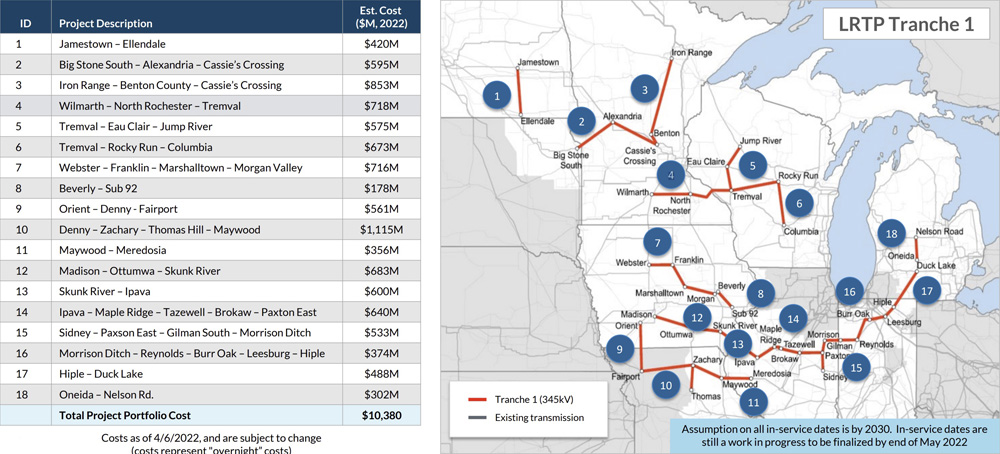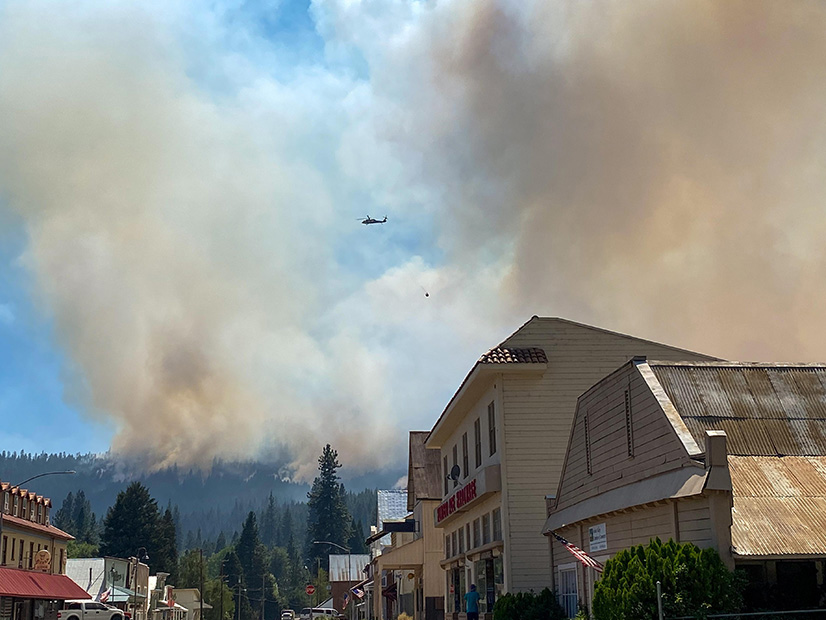The cost to New Jersey ratepayers of building transmission infrastructure tying the state’s offshore wind projects to the grid could be cut, and the risk of cost overruns diminished, under some of the 80 proposed projects submitted to the state Board of Public Utilities (BPU), stakeholders at a hearing into the issue argued Tuesday.
Such a strategy, if approved by the BPU, would provide a transmission system for about half of the 7.5 GW of offshore wind planned by the state, said developers and stakeholders during the three-and-a-half hour hearing on the BPU’s planning process with PJM under FERC’s State Agreement Approach (SAA). That would be a stark departure from the plans in place for the development of transmission infrastructure for the first half of the planned offshore wind capacity.
Each of the three offshore wind projects awarded by the BPU so far — Ocean Wind 1, Ocean Wind 2 and Atlantic Shores, which collectively would generate 3.758 GW of power — will design and develop their own transmission infrastructure. But the SAA process would allow one or more developers focused solely on transmission issues to design the infrastructure to connect projects awarded in the future to the grid.
Having a single project serve several projects could reap efficiencies of scale, create a more reliable system and reduce the cost to ratepayers through competitive bidding coupled with cost caps to prevent the amount paid by ratepayers from escalating beyond the contracted amount, developers said.
Becky Walding, executive director of development for NextEra Energy Transmission MidAtlantic (NYSE:NEE), said the company had calculated that the process could save “customers billions of dollars” if it results in transmission infrastructure serving several wind farms, rather than each providing their own cable system.
“There is the possibility for substantial cost savings,” added Theodore Paradise, executive vice president of transmission strategy for Anbaric Development Partners. “If you’re avoiding more cables, more trenching, more shore landings, more upgrades [and] more substation expansions because you’re making the most out of the breaker positions that you have in a substation, those are the sorts of things that can really save some money.”
But Larry Gasteiger, executive director of trade association WIRES, urged the BPU to proceed with caution. Cost caps can be weakened by “exclusions” that allow items to be charged outside the cap, and focusing on a project’s cost can sometimes be detrimental to ratepayers, he said.
“The real question here is: Do you really want the cheapest upfront design for your transmission solutions?” he said. “It raises a number of other related questions such as, what is the risk tolerance for what may be a cheaper, but less proven or unproven design over perhaps something that may wind up being more costly in terms of the design, but uses a more well established or more proven track record as the basis for that design?”
Risk vs. Cost Trade-off
The issue of how best to structure the development of future transmission infrastructure emerged as one of the most contentious topics at the BPU’s fourth and final hearing into the SAA proposals, which focused on “ratepayer protections and cost controls.” Under the SAA process, the BPU, working with PJM, solicited proposals for developing links between the grid and the offshore wind projects.
The last meeting in the series included a presentation by Michelle Manary, acting deputy assistant secretary of the Energy Resilience Division at the U.S. Department of Energy, on federal funding for offshore wind, and a panel discussion afterward that included three transmission project developers; Gasteiger; the director of the New Jersey Division of Rate Counsel; and a representative of PSEG, which owns 25% of one of the state’s offshore wind projects and submitted transmission proposals with Ørsted.
Earlier hearings presented the 80 proposals submitted by 13 developers and focused on permitting and environmental issues and grid integration issues.
The BPU, working with The Brattle Group expects to decide by October whether to adopt any of the proposals. Alternatively, it could reject them all and continue as it has so far. (See Fierce Competition in Plans to Upgrade NJ Grid.) The board has held two offshore wind solicitations and awarded three projects, each of which included the design of a transmission system to bring the power to the grid. Three more solicitations are planned, the first to take place in January 2023. (See NJ Awards Two Offshore Wind Projects.)
Rate Counsel Director Brian O. Lipman said the BPU, in assessing the proposal, needs to focus on key benefits to the state, and not get distracted by broader issues.
“For this proceeding, the real issue is not about addressing the pre-eminent challenge of climate change, but rather how will New Jersey select resources that are economically sustainable and environmentally sustainable; in this case, transmission lines,” he said. “The only issue is whether any of the proposed offshore wind transmission projects meet these goals. And if so, which are the best fit?”
The rate counsel encouraged the state only to support projects that would benefit New Jersey and not “promote regional solutions to OSW development along the Atlantic Seaboard.” New Jersey ratepayers should “not be placed in the position of subsidizing OSW development benefits for other states and regions,” he said. State officials in the past have expressed a more expansive view, saying they want New Jersey to be an offshore wind manufacturing and supply chain hub that can serve other states. (See NJ Plans ‘Flagship’ R&D Innovation Center for Wind.)
Lipman said the BPU should pick projects that fit the state’s needs and not “facilitate overdevelopment” that could “place New Jersey ratepayers in the position of having to bear the risk of future project OSW transmission benefits that never materialize.” He added that the BPU should look for projects that “offer to mitigate or assume some risks,” such as development, financial, market and regulatory risks, and require the developer to take on some of them.
“It is likely that any offer to mitigate these risks will not come free,” he said. “Thus, balancing risks and costs to determine the most advantageous proposal or proposals will involve some tradeoffs.”
Structuring the Deal
The projects would be funded by a tariff authorized by FERC that would amortize the cost of the projects over their life. PJM would then allocate the costs to the utilities serving the state, who would in turn charge the cost as a transmission fee in ratepayer bills.
How that will impact ratepayers is not clear. Lathrop Craig, vice president of development for Public Service Enterprise Group (NYSE:PEG), said the company has yet to calculate the cost of transmission, which will in any case vary depending on which project or projects the BPU chooses. But PSEG calculated that the entire cost of each of the three offshore wind projects approved so far would for the average residential account be “in the low single-digit dollars per month,” so the cost of just transmission would be much less, he said.
Speakers differed, however, on the best way to keep those costs down and curb the risk to ratepayers of rising costs.
Clint Plummer — CEO of Rise Light & Power, a New York-based wind project development company that is a subsidiary of LS Power — argued that giving the developer responsibility for all the offshore transmission infrastructure, as well as developing the project, would secure efficiencies by “putting the developers in control of every piece of the project.” That strategy has worked successfully in the past, he said.
“You give the developers not only the ability to manage their projects to deliver a lower cost to ratepayers, [but] you put more of the risk on the developers” and keep it off the ratepayers, Plummer said. Rise submitted a proposal to provide the onshore interconnection by developing a former fossil fuel plant, the Werner Generating Station in South Amboy, on a bay that fronts the New York Bight. He also argued that “it’s very difficult to optimize a wind farm if you don’t control the means by which you’re delivering your final product to market.”
But other developers argued that a separate competitive selection process to pick the transmission infrastructure would drive down costs.
“The competitive pressure of the State Agreement Approach will create tremendous value for New Jersey ratepayers in terms of cost savings and risk mitigation,” said Lawrence Willick, executive vice president of transmission regulatory for LS Power, which submitted proposals to build both onshore and offshore transmission infrastructure.
The process also will protect ratepayers by including cost caps “to actually contain the cost of transmission” development and prevent them from getting burdened with cost overruns from issues such as unforeseen schedule delays, said Anbaric’s Paradise.
AC vs. DC
A key element of the transmission system’s cost structure, however, comes from the technology used, said developers, who offered differing visions at the forum. The issue centers on whether the project uses high-voltage alternating current (HVAC) or HVDC, which is more efficient for transferring power over long distances because it incurs less power loss.
Rise CEO Plummer said HVDC systems come in “large blocks” of 1,100 to 1,500 MW, and that unless the project is a multiple of those sizes, its use would result in the creation of wasted capacity. HVAC, meanwhile, comes in blocks of 400 MW, which is far more flexible and suitable for most of New Jersey’s offshore wind areas, he said.
“HVDC makes a lot of sense for sites that are really far from shore,” he said. But more than 70% of the offshore wind area still to be leased in New Jersey “can connect to the shore with HVAC technology,” he said. “That has real advantages because HVAC is not only a more proven technology in the offshore environment, but it also is a lot cheaper.”
Willick agreed that the “distances really aren’t that long to justify the higher cost of the DC terminals,” and that HVAC systems have the benefit of lasting longer than HVDC systems, which would likely need to be replace during the project’s life.
“So really, if an AC approach does work, and is feasible, then that’s the best approach,” Willick said. “It integrates with the existing system and avoids the high cost and losses of the DC equipment.”
Paradise argued that HVDC is the best option if the state is planning for large capacity. Such a system would avoid creating “the spaghetti of all of those radial lines” running from each project to the shore and be cost effective, he said.
Anbaric submitted proposals for both transmission corridors and an offshore network. It estimated that New Jersey’s entire planned wind farm capacity of 7,500 MW could be handled by five HVDC cables, whereas it would require 19 HVAC cables, Paradise said.
“If you’re going to go big in terms of significant amounts of megawatts and building out robust transmission systems,” HVDC is preferred, he said. “So, if New Jersey is saying 7,500 [MW] is a down payment, but we want to go to 15,000 [MW], then designing a system is really important.”
NextEra’s Walding said the company designed the projects it planned to submit in two scenarios, AC and DC, and found the latter to be cheaper.
“We actually didn’t even propose the AC because it was significantly more, to the tune of 50% more expensive,” she said. “It ended up with more platforms in the ocean on that design. And, so from a cost perspective, we didn’t feel like it was the right thing.”



